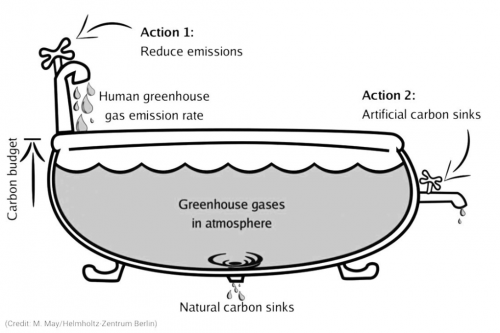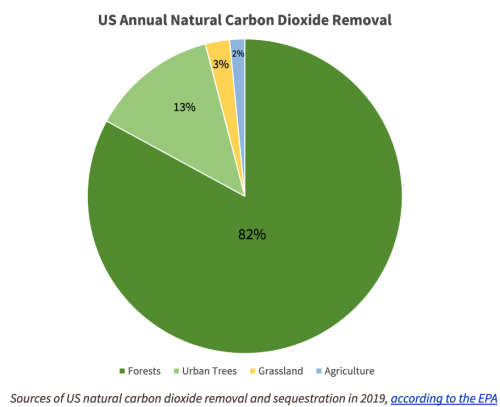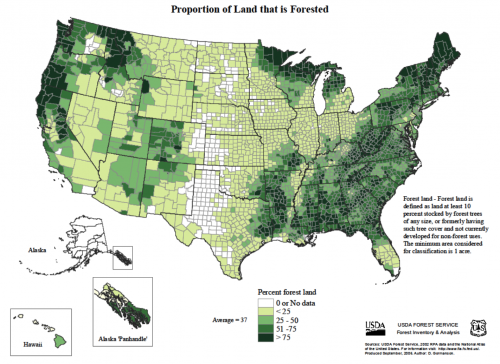Advanced Training on Healthy Forests
This advanced training reviews the need for approaches to remove and sequester carbon from the air, the role trees and forests can play, and the other benefits that those solutions provide as part of CCL's policy agenda. Please also see our Introductory Training on this topic.
Background on the need for carbon sequestration
We can think of Earth’s atmosphere like a bathtub, and greenhouse gases are equivalent to the water filling the tub. The tub is already overflowing and beginning to cause increasing damage to the floor and the rest of the bathroom as the water spreads, like the worsening extreme weather damages resulting from Earth’s rapidly changing climate.
To limit the damage, there are two main categories of solutions. First, we need to rapidly turn down (and eventually turn all the way off) the faucet. That will mainly involve phasing out the emissions from fossil fuels by building a clean energy economy. Second, we need to drain water from the bathtub. That’s where removing carbon from the atmosphere and sequestering it in natural and artificial technological “sinks” comes in. Trees and forests are a key example of natural carbon removal and sequestration:

It’s also critical to understand that many climate advocates are wary that carbon sequestration efforts will distract from measures to reduce emissions, or that carbon polluters will use them as an excuse to continue burning fossil fuels. The latest Intergovernmental Panel on Climate Change (IPCC) report was very clear that carbon removal and sequestration measures “cannot compensate for delayed emissions reductions.” Meeting the Paris targets will require both maximal emissions reductions and maximal carbon removal and sequestration efforts.
How much carbon sequestration is needed?
Removing at least 10 billion tons (gigatons, or Gt) of carbon dioxide from the atmosphere per year by 2050 is a reasonable ballpark target, as discussed below.
The IPCC report noted that carbon removal and sequestration can serve three purposes over different timescales:
- In the short term, it can reduce net human greenhouse gas emissions.
- In the medium term, the IPCC noted that “the deployment of carbon dioxide removal to counterbalance hard-to-abate residual emissions is unavoidable if net zero CO2 or GHG emissions are to be achieved.” These hard-to-eliminate emissions include certain industrial activities, agricultural practices and long-distance transport.
- In the long term, it can draw down the amount of carbon in the atmosphere to gradually reduce global temperatures to safer levels.
In a 2019 report, the National Academy of Sciences estimated that more than 10 Gt of greenhouse gases come from sources that will probably be very difficult or expensive to eliminate. So, since meeting the Paris targets of limiting global warming to less than 2°C above pre-industrial temperatures and ideally close to 1.5°C will require reaching net zero emissions somewhere between 2040 and 2080, 10 Gt of carbon dioxide removal and sequestration per year by 2050 is a reasonable global target.
Nationally, a 2022 study in Science suggested that to meet its 2030 Paris commitment, the U.S. would need to boost its annual natural carbon dioxide removal and sequestration from about 790 million tons (Mt) today to between 860 Mt and 1.16 Gt over the next 8 years (a 7–50% increase). The analysis found that most of that increase would likely come from trees, whose growth currently accounts for 95% of U.S. annual carbon removal and sequestration.

How much carbon sequestration can healthy forests provide?
Research suggests that natural systems alone could deliver the carbon removal and sequestration we need by 2050, if we could fully maximize their potential.
Earth’s plants and soils collectively store more than three times as much carbon as currently resides in the atmosphere, so boosting that natural carbon storage offers significant potential toward curbing climate change. Several studies, including the aforementioned National Academy of Sciences report, agree that at a relatively modest cost of under $100 per ton of carbon dioxide, natural systems could remove over 10 Gt per year globally by 2050. That includes about 1 Gt from the U.S., much of which would come from forests.
In the United States, nearly one-third of the nation’s land area today is covered by forests, comprising about 228 billion trees. They currently offset about 12% of American annual greenhouse gas emissions. The National Academy of Sciences report and several other studies suggest that fully replenishing all forestland that’s been depleted by factors like land use change and wildfires, plus improving forest management practices, could increase American forest carbon dioxide removal and sequestration by about 200–600 Mt per year (20–60% of the 1 Gt increase the National Academy of Sciences suggests the U.S. could achieve). This would offset a total of 15–22% of current annual national emissions, up from the current 12%. And a recent study found that, in order to meet America’s 2030 Paris commitment, nature-based solutions (especially forests) will need to play a key role, accounting for about 8% of the greenhouse gas reductions needed over the remainder of this decade.
About half of U.S. forest land is privately owned and harvested for products like wood and paper. Three-quarters of American forests' carbon removal and sequestration comes from these “private working” forests. While large old-growth trees commonly found in publicly owned non-working forests are an important carbon storage system, it’s younger trees whose growth draws more carbon dioxide from the atmosphere every year. It’s thus important to both conserve old growth forests and the carbon they store, and to sustainably harvest and plant new trees that can pull additional carbon dioxide out of the atmosphere, especially if those harvested trees are used for durable wood products that can also continue to store carbon.
What about harvested tree uses like wood pellets and durable wood products?
The climate impacts of harvested trees will vary depending on their use. For example, if the trees are converted into compressed wood pellets and burned for energy at a facility that doesn’t capture the released carbon, that carbon will return to the atmosphere where it will increase the greenhouse effect. But if the resulting energy reduces the need to burn fossil fuel sources like coal, oil, or gas – which is usually the case – the climate picture becomes more complicated.
A newly planted replacement tree can eventually draw that released carbon back from the air and thus make the energy carbon-neutral in the long-term, but it takes decades for a tree to grow large enough to absorb all the carbon released from another tree’s burned wood. In the meantime, that carbon would conceptually add to near-term global warming. However, a forest is a dynamic system with carbon stock ranging from new saplings to dead trees that are already releasing their carbon as CO2 through microbial or fungal decomposition. So the net climate impact of burning wood for energy depends on forest management and harvesting practices.
Using the wood from harvested trees for a long-lasting product like a building frame or furniture has a more certain climate impact. The carbon in a durable wood product can remain stored for many decades and even up to a century – as long as the product and its wood remain intact without decaying. There is growing interest in the use of mass timber products in building construction. Using wood as a building product instead of carbon-intensive materials like steel and concrete can both reduce buildings’ carbon footprints by about a quarter to a third and also increase the amount of carbon stored in durable wood products. The Inflation Reduction Act provided $100 million to the U.S. Forest Service for a wood innovation grants program to identify even more uses and markets for wood products.
What are the biggest potential forest policy solutions?
According to a 2018 paper, most of the potential carbon sequestration from American forests comes from two categories: reforestation (restocking or restoring forests that have lost trees or been converted to other land uses) and forest management (engaging in forestry practices that better preserve carbon sequestration in the ecosystem).
According to the Nature Conservancy’s Reforestation Hub tool, which is based on a 2020 study, about half of the potential carbon sequestration from American reforestation stems from pastureland. This is land mostly in southeastern states like Tennessee, Alabama, Mississippi, Texas, Kentucky, Virginia, Georgia, North Carolina, Arkansas and Florida, where some forested ecosystems were long ago converted to pastureland. But because they used to be forests, we can be confident that these areas are suitable ecosystems for planting trees once again. The practice of silvopasture – integrating trees and livestock grazing on the same land – has tremendous potential in these states. It would allow ranchers to continue using the land as pasture, while planting trees could provide beneficial shade for their livestock in a region that is highly vulnerable to worsening extreme heat.
Urban open spaces account for the next largest proportion of America’s reforestation potential, at about 20% of the total. In addition to their carbon sequestration benefits, urban trees can also provide shading and cooling services in hot cities, improve air quality, and other co-benefits as discussed in the section below.
For forest management, the most effective practice involves extending tree harvest cycles by harvesting trees at older ages. Engaging in harvesting practices that have less impact on the surrounding trees and soil could also increase forest carbon sequestration. And fire management practices – for example, engaging in prescribed burns to reduce the dense vegetation fuel load available during wildfires – would reduce the carbon released into the atmosphere during large wildfires, while providing the additional benefits associated with reduced megafire and smoke risks in wildfire prone areas.
What about wildfires and other climate impacts on forests?
Forests are vulnerable to a variety of climate change impacts including wildfires, bark beetle infestations, droughts and heatwaves. When trees burn or decay as a result of these climate impacts, their stored carbon is released back into the atmosphere.
For example, an analysis by Carbon Plan suggested that, due to its recent large wildfire seasons, California’s forests may have released more carbon than they removed from the atmosphere over the past several years and will likely continue to do so in the future. As a result, carbon storage permanence is a challenge for forestry solutions. It’s thus important for forestry policy to take climate change into account, as discussed in the section below.
Fortunately, the southern states include the largest proportion of forested area in the country, with about half of their land area covered by forests, and this region has not been subject to the record droughts, wildfires, and bark beetle outbreaks plaguing the western states.

Percent of land in each county that is forested, according to the US Forest Service.
Co-benefits and the importance of tree equity
Trees provide many valuable benefits in addition to helping curb climate change. For example, conserving and restoring depleted forests can help protect biodiversity in those ecosystems, and climate-smart forestry practices can help lessen the severity of wildfires.
Trees also provide physical and mental health benefits. Research has shown that spending time around trees reduces stress, lowers blood pressure and improves mood. Trees also improve air quality and provide cooling, which are particularly important services in urban areas whose residents face significant physical health risks due to a high density of local pollution sources and heat emanating from surfaces like asphalt and concrete. One recent study found that in 35 U.S. metropolitan areas, about 36,000 premature deaths could have been avoided over the past 20 years by planting more trees.
According to a Tree Equity Score analysis done by American Forests, communities of color have 33% less tree canopy on average than majority white neighborhoods, and poor communities have 41% less tree canopy than wealthy neighborhoods. Smart urban tree planting can thus both contribute to slowing climate change and begin to reverse this source of environmental injustice, while improving those neighborhoods’ resilience and ability to adapt to certain climate change impacts like extreme heat.
Bipartisan support and local engagement
There have been numerous bills related to forests that have been introduced in Congress and include both Republican and Democratic cosponsors. Among these is the FOREST Act, which would restrict goods originating from illegally deforested land. It has bipartisan support in both chambers of Congress and has been included among CCL’s supporting asks.
It’s important to ensure that forestry legislation does not encourage activities such as clearcutting forests or monoculture tree planting that do more harm than good. CCL will not support counterproductive forestry legislation. Fortunately, recent research has shown that with proper oversight and nutrient availability, forests can regenerate more quickly than they did in the past, so sustainable forest management is achievable. A 2010 study showed that higher temperatures and CO2 levels can actually increase carbon sequestration in forests, but only if adverse climate effects like fires and drought don’t wipe out any potential gains.
Volunteers can also engage with solutions like tree planting at the local level. For example, the Girl Scout Tree Promise aims to plant five million trees in five years. Local tree projects offer the opportunity for volunteers to engage in climate solutions in their own communities, while potentially helping to alleviate the problem of tree inequality in low-income neighborhoods and communities of color.
What are the best trees to plant in my community?
The answer to this question depends on a variety of different factors. Every region and specific area has different factors that determine the best suited tree species for a given project, like the local climate, water availability and space constraints.
The Arbor Day Foundation has a useful primer with information about these different criteria and a best tree finder tool. When considering a new tree planting project, it’s also a good idea to engage with other local groups and experts. Community tree projects provide excellent opportunities to collaborate and build relationships with local climate and environmental groups who may already be engaging in this space. Local governments and universities will also often have tree and city planning experts who can provide valuable input to ensure that your project is successful.
Intro & Agenda
(0:00)
Why Forests?
(3:12)
Forestry Solutions
(17:57)
Forestry Opportunities, Challenges
(25:17)
Tree Equity & Benefits
(28:43)
- Dana Nuccitelli
Intro & Agenda
(0:00)
Why Forests?
(3:12)
Forestry Solutions
(17:57)
Forestry Opportunities, Challenges
(25:17)
Tree Equity & Benefits
(28:43)
- Dana Nuccitelli
- CCL's Agriculture & Forestry YouTube page and action team home page
- American Forests website
- Reforestation Hub tool
- Natural climate solutions for the United States | Science Advances
- World Resources Institute CarbonShot federal policy options report
- Tree Equity Score analyzer
- Sustainable Forestry Initiative website
- National Academy of Sciences report on carbon dioxide removal
- IPCC Sixth Assessment Report, Mitigation Volume
- What you need to know about carbon dioxide removal
- Arbor Day Foundation: Planting the right trees in the right places
- Talk to your local tree and forest experts